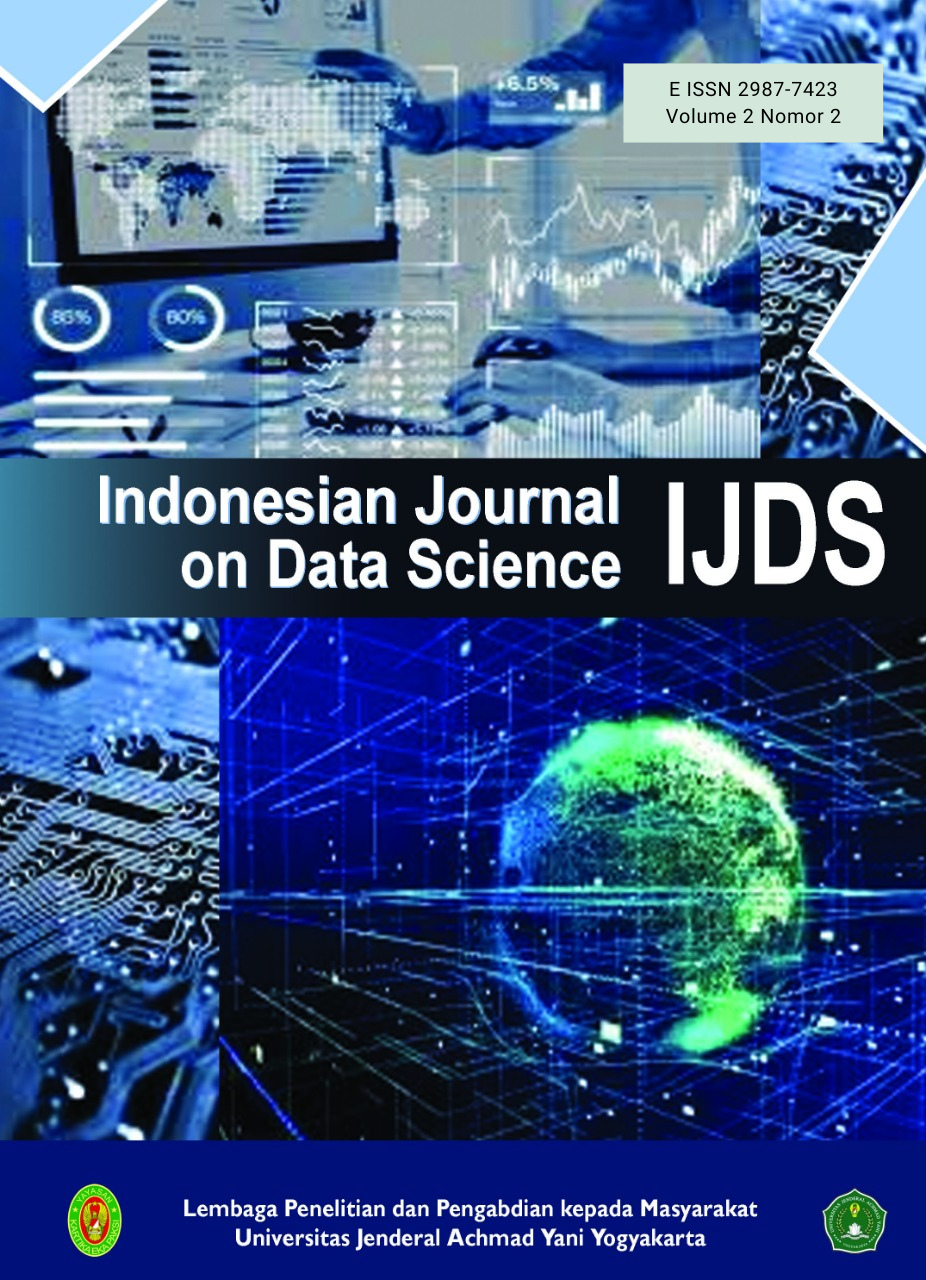Penerapan Algoritma Support Vector Machine (SVM) untuk Deteksi Penyakit Mata Katarak
Algoritma Support Vector Machine (SVM) untuk Deteksi Penyakit Mata Katarak
DOI:
https://doi.org/10.30989/ijds.v2i2.1449Keywords:
Support Vector Machine, Kernel LBF, Prediction, Feature Extraction, AccuracyAbstract
Eye diseases are one of the health disorders that can have serious consequences if not diagnosed early. In an effort to improve the accuracy and efficiency of eye disease detection, the Support Vector Machine (SVM) method is used for classifying eye diseases based on image datasets or related numerical data. This research aims to implement SVM as a classification algorithm, utilizing features extracted from eye images or relevant medical data. The research process includes data collection, preprocessing, feature extraction, SVM model training, and model performance evaluation using accuracy, precision, recall, and F1-score metrics. By applying k-fold cross-validation techniques, the model is tested to avoid overfitting and ensure good generalization. The results of the study show that the SVM method can provide accurate classification results and can be used as an effective tool for diagnosing eye diseases.
References
[1] F. Tabei, “(72) Inventors: Behnam Askarian, Lubbock, TX (US ); Jo Woon Chong, Lubbock, TX (US );”.
[2] A. Saini, K. Guleria, and S. Sharma, “An Efficient Deep Learning Model for Eye Disease Classification,” in 2023 International Research Conference on Smart Computing and Systems Engineering (SCSE), Jun. 2023, pp. 1–6. doi: 10.1109/SCSE59836.2023.10215000.
[3] B. Askarian, P. Ho, and J. W. Chong, “Detecting Cataract Using Smartphones,” IEEE J. Transl. Eng. Health Med., vol. 9, pp. 1–10, 2021, doi: 10.1109/JTEHM.2021.3074597.
[4] “IEEE Xplore Citation BibTeX Download 2024.9.23.16.20.53.”
[5] M. A. M. Kaaffah, A. Hidayatno, and Y. A. A. Soetrisno, “Sistem Klasifikasi Ukuran Baju Dengan Metode Support Vector Machine (Svm),” Transient J. Ilm. Tek. Elektro, vol. 9, no. 1, pp. 17–25, Mar. 2020, doi: 10.14710/transient.v9i1.17-25.
[6] R. Umar, I. Riadi, and D. A. Faroek, “Komparasi Image Matching Menggunakan Metode K-Nearest Neighbor (KNN) dan Metode Support Vector Machine (SVM),” vol. 4, no. 2.
[7] A. D. Pratama and H. Hendry, “Analisa Sentimen Masyarakat Terhadap Penggunaan Chatgpt Menggunakan Metode Support Vector Machine (Svm),” JIPI J. Ilm. Penelit. Dan Pembelajaran Inform., vol. 9, no. 1, pp. 327–338, Feb. 2024, doi: 10.29100/jipi.v9i1.4285.
[8] A. Dwi Cahyo, S. Anardani, and Y. P. Yuda, “Prediksi Beban Daya Listrik (W) Menggunakan Metode Support Vector Machine (SVM) Pada Listrik Token Rumah Tangga,” J. Sains Dan Teknol. JSIT, vol. 4, no. 1, pp. 70–77, Feb. 2024, doi: 10.47233/jsit.v4i1.1543.
[9] N. Salman, “Image Segmentation Based on Watershed and Edge Detection Techniques”.
[10] O. A. and B. O, “An Iris Recognition and Detection System Implementation,” Int. J. Inven. Eng. Sci., vol. 5, pp. 8–10, Feb. 2020, doi: 10.35940/ijies.H0958.025820.
[11] A. Albelaihi and D. M. Ibrahim, “DeepDiabetic: An Identification System of Diabetic Eye Diseases Using Deep Neural Networks,” IEEE Access, vol. 12, pp. 10769–10789, 2024, doi: 10.1109/ACCESS.2024.3354854.
[12] I. K. Karinasari, “Deteksi Dini Penyakit Iugr (Intra Uterine Growth Retriction) Dengan Metode Svm (Support Vector Machine),” KLIK - Kumpul. J. ILMU Komput., vol. 7, no. 2, p. 176, Jun. 2020, doi: 10.20527/klik.v7i2.321.
[13] Z. Zeng et al., “Evaluation of Methods for Detection and Semantic Segmentation of the Anterior Capsulotomy in Cataract Surgery Video,” Clin. Ophthalmol., vol. Volume 18, pp. 647–657, Mar. 2024, doi: 10.2147/OPTH.S453073.
[14] A. Nofandi, N. Y. Setiawan, and D. W. Brata, “Analisis Sentimen Ulasan Pelanggan dengan Metode Support Vector Machine (SVM) untuk Peningkatan Kualitas Layanan pada Restoran Warung Wareg”.
[15] R. Nooraeni, H. D. Sariyanti, A. F. F. Iskandar, S. F. Munawwaroh, S. Pertiwi, and Y. Ronaldias, “Analisis Sentimen Data Twitter Mengenai Isu RUU KPK Dengan Metode Support Vector Machine (SVM),” Paradig. - J. Komput. Dan Inform., vol. 22, no. 1, pp. 55–60, Mar. 2020, doi: 10.31294/p.v22i1.6869.
[16] K. Kelvin, J. Banjarnahor, E. I. -, and M. Nk Nababan, “Analisis perbandingan sentimen Corona Virus Disease-2019 (Covid19) pada Twitter Menggunakan Metode Logistic Regression Dan Support Vector Machine (SVM),” J. Sist. Inf. Dan Ilmu Komput. PrimaJUSIKOM PRIMA, vol. 5, no. 2, pp. 47–52, Feb. 2022, doi: 10.34012/jurnalsisteminformasidanilmukomputer.v5i2.2365.
[17] F. Bei and S. Saepudin, “Analisis Sentimen Aplikasi Tiket Online Di Play Store Menggunakan Metode Support Vector Machine (Svm),” Pros. Semin. Nas. Sist. …, 2021, [Online]. Available: https://sismatik.nusaputra.ac.id/index.php/sismatik/article/view/13
Downloads
Published
Issue
Section
Citation Check
License
Copyright (c) 2025 Yonal Supit

This work is licensed under a Creative Commons Attribution-ShareAlike 4.0 International License.
Indonesian Journal On Data Science allows readers to read, download, copy, distribute, print, search, or link to its articles' full texts and allows readers to use them for any other lawful purpose. The journal allows the author(s) to hold the copyright without restrictions. Finally, the journal allows the author(s) to retain publishing rights without restrictions
- Authors are allowed to archive their submitted articles in an open access repository
- Authors are allowed to archive the final published article in an open access repository with an acknowledgment of its initial publication in this journal

This work is licensed under a Creative Commons Attribution-ShareAlike 4.0 Generic License.



